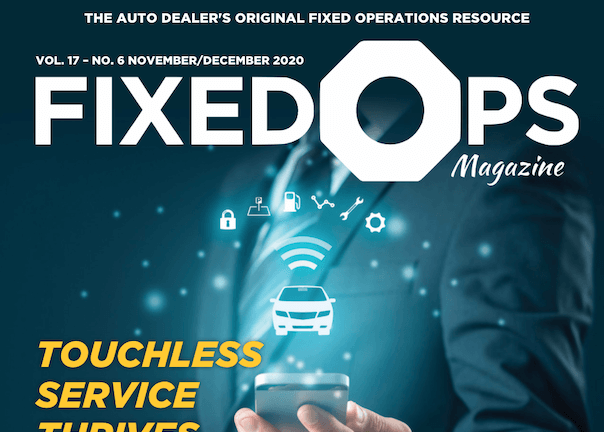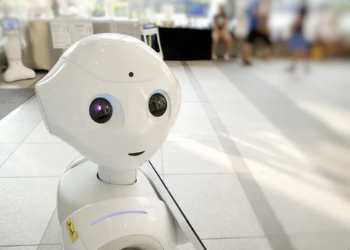Any Fixed Ops department is trying to achieve high productivity and customer satisfaction. What many do not realize is the potential impact of employee scheduling on these goals. With highly variable demand and time-sensitive customers, proper scheduling is particularly challenging. We believe there is a better way. The following illustrates how to raise employee scheduling to a new level. Starting with a standard of success, followed by methods to measure performance, this article will conclude with how AI can be leveraged to achieve optimum results for your customers, employees, and business.
What success looks like
For any business, employees are the engine of success. Service departments depend on having the right people on at the right time, to deliver value to their customers when they need it.
The day-to-day scheduling of employees is generally handled by managers. While seemingly a straightforward task, doing it well is not easy. A manager is expected to create schedules that balance the time needs of employees, customers, and the business. But what does good employee scheduling look like? How does a manager know when they are properly staffed?
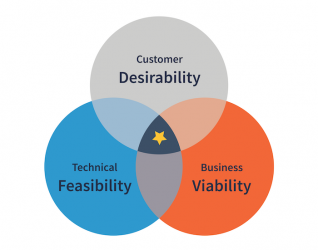
To answer these questions, we refer to a concept typically used in product innovation, known as Design Thinking. Popularized by the global design company IDEO, this approach is usually applied to design and develop human-centered new products. We will apply these same principles here to design the optimum employee schedule. The primary aim of design thinking is to achieve three attributes: customer desirability, technical feasibility and business viability. Let’s explore what these might look like in the context of employee scheduling.
Desirability refers to how attractive a solution is for a potential customer. In workforce scheduling, this means providing a schedule that ensures a business is able to serve customers when and where the customer desires. A good schedule, therefore, is one that matches customer demand, avoiding excessive wait times and delivering an exceptional customer experience.
Feasibility refers to the technical ability of a business to provide the solution. In other words, we need a schedule that is workable for employees. Assigning shifts that do not align with employee needs may work in the short term but will lead to unhappy employees and poor service for customers in the long term. Similarly, workload needs to be both sufficient and achievable for the workforce. Insufficient work leads to disengaged employees, and excessive work leads to burnout.
Viability refers to the ability to deliver value in a way that provides sufficient return for the business to continue to operate. Schedules need to ensure sufficient value is created for customers (revenue) with adequate efficiency (cost) to generate a profit. In other words, enough employees need to be on the clock to serve customers on a timely basis, but not so many workers that the labor expense eats away all profits.
If employees are the engine of a service business, scheduling is the ignition system to spark peak business performance. Intelligent scheduling must balance the needs of customers, employees, and the business, making your service desirable, feasible and viable. So, what does this look like in practice? Engaged employees, delighted customers, and a profitable business.
How to measure performance
If the purpose of employee scheduling is to harmonize the time needs of customers, employees, and the business, how do we go about measuring performance against this standard? Let’s start with how to recognize the error states. Then we can turn to measures of success.
Envision your nearest oil change center. Somewhere around mid-afternoon, employees are standing around looking at their phones because there is insufficient customer flow to keep them busy. This is a point in the day when the business is overstaffed. But then just an hour later, the cars start to back up outside the bays. With a sudden surge of customers, employees are no longer able to keep up and the customer experience suffers. Just an hour after being idle, the business is unable to keep up with demand.
These two symptoms, overstaffing and understaffing, often occur together due to the fluctuating demand of a service business. It is difficult to predict workload peaks and valleys, causing a location to have too many employees one hour, and not enough the next.
These paired error states cause measurable negative impacts on several aspects of the business. First, overstaffing leads to excessive labor costs due to having employees on the clock when there is insufficient workload to generate revenue. Second, understaffing leads to customer dissatisfaction due to excessive wait times and rushed service at the peaks of demand. And finally, employee engagement suffers due to both the peaks and valleys: the stress of excessive workload and the boredom of inadequate work. High cost, poor customer service, and unhappy employees—not what any of the stakeholders want!
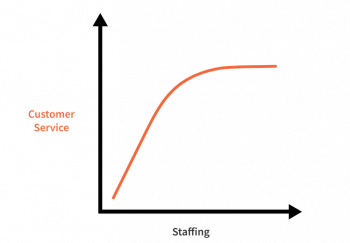
Many businesses try to address one of these symptoms at the expense of another. For example, some focus primarily on delivering at low cost and therefore consistently understaff despite the impact on customer service. Others overstaff to offer a premium customer experience but incur high labor costs.
We believe there is a better way: it is possible to achieve both great customer service and high productivity.
Consider first the relationship between staffing and customer service. In general, low staffing yields poor customer service, and high staffing enhances it. But for a given level of workload, there is also a point of diminishing returns, where additional staffing no longer contributes significantly to better service.
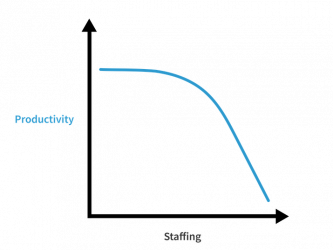
On the flip side, consider the relationship between staffing and productivity. Here, reducing the number of employees to complete a certain amount of work (moving from right to left on the staffing axis) will generally increase productivity. But here, too, comes a point at which the employees cannot get the work done any faster and productivity flattens out. Again, diminishing returns.
Now this really gets interesting when you combine the two measures. Given the inverse relationship between the two, adjusting the staffing lower or higher will inherently include some trade-offs. But there is also a target range in the middle, where you achieve both productivity and customer satisfaction. This is the sweet spot for employee scheduling.
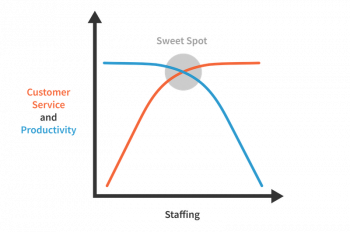
This all seems rather simple in theory, but there are several challenges that make workforce optimization difficult in practice. One of the challenges in achieving the targeted sweet spot is the difficulty of measuring customer satisfaction. Many of the usual indicators aim for comprehensiveness but are slow to measure. They lag so far behind operations that they are ineffective as a feedback loop for proper staffing.
An effective remedy to this challenge is to find a proxy metric that correlates highly with customer satisfaction but provides more timely feedback. For many service businesses, customer wait times is a suitable metric. A more comprehensive metric would also include service quality, but for most customers time is a key deciding factor.
Reflecting on the example of the oil change center, you can see an additional challenge a manager faces when scheduling employees. Optimizing for a given workload only works if you know what that workload is going to be. For a service business, this is both difficult to anticipate and highly variable. You may be properly staffed one hour, but not the next. This perpetual challenge is what we address in the next section.
Balancing the needs of customers, employees, and businesses through optimum employee scheduling is inherently difficult. But recognizing the potential benefits in terms of productivity and customer satisfaction, it is also fundamental to address this challenge for the health and sustainability of a business.
There is a better way.
Optimizing with AI
Now that we have outlined workforce scheduling success and how to measure it, let’s break down how to achieve this high standard. There are three fundamental pieces to the process: forecasting, staffing, and scheduling. Applying the latest technology enables a step-change improvement in each of these dimensions.
1. Forecasting
Whether they realize it or not, a manager typically uses a forecast to drive the scheduling process. It may be as simple as recognizing, for example, “Friday nights are busy, so I need an extra person.” But today, with data at our fingertips, we recommend a more comprehensive and robust process for forecasting demand.
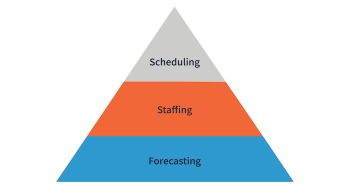
As you increase the data you include in a forecast, you decrease the band of uncertainty around your prediction. At the most basic level, a business should be looking at prior sales data. Last week, last month, and last year are all valid reference points. But why not also include how many employees were on the clock and even how busy you were? And why not add data around your planned promotions, related online search traffic, and the weather forecast? Have you considered including data related to COVID infection rates, government restrictions, and local economic trends?
A manager generally recognizes the relevance of these factors and their potential relationship to demand, but only recently did it become possible to fully connect and utilize the available information. While a human is limited in the number of factors they can reasonably consider in a forecast, a machine is not. Applying artificial intelligence (AI) opens the door to including all the signals mentioned above, and more. With the breadth and depth of data accessible now, we can provide a much more reliable forecast than ever before.
2. Staffing
The number of staff establishes the long-term operational capacity for an organization. With an AIbased forecast in hand, an organization is well equipped to staff in a data-driven way. Building on the foundation of an accurate forecast, the organization can anticipate hiring needs and grow the team proportionally to expected demand. Additionally, they can evaluate the team structure and skill mix to make any necessary adjustments.
Staffing analytics will not eliminate challenges with hiring or training employees, but it will enable informed decisions about the real operating capacity and projected needs. Used appropriately, it also holds the potential to reduce excessive overtime costs.
3. Scheduling
Setting employee schedules is where the rubber meets the road in this process. While there are many tools on the market to help with this job, most are built to reduce the administrative burden but lack sophistication to support the core decision-making. They enable manual building of shifts and assigning to employees, but don’t inform a manager how many people should be working.
Even tools that claim “automatic” shift scheduling typically do this using templates. These may allow for simple fluctuations in demand, but likely miss any week-to-week or seasonal changes. Nor do they account for the full breadth of factors described in the prior section. Building instead on the foundation of the AI demand forecast yields a much closer match to actual demand. Applying advanced algorithms to generate shifts will then enable dynamic schedules that are not only easy to create but also accommodate ever-changing customer flow.
Most managers should be applauded for how well they have historically scheduled their workforce, given the challenge of balancing the needs of customers, employees, and the business. But the technologies available today open up a better way to satisfy the competing demands of a schedule. They empower managers with data, AI forecasting, and advanced algorithms, so that they will be able to consistently deliver the targeted sweet spot for high productivity and exceptional customer service, thus taking employee scheduling to the next level. With the proper tools to predict demand and create schedules, this method moves from an abstract analysis to an actionable approach to accommodate the peaks and valleys of demand. Isn’t this a better way?
Source: FixedOps Magazine
